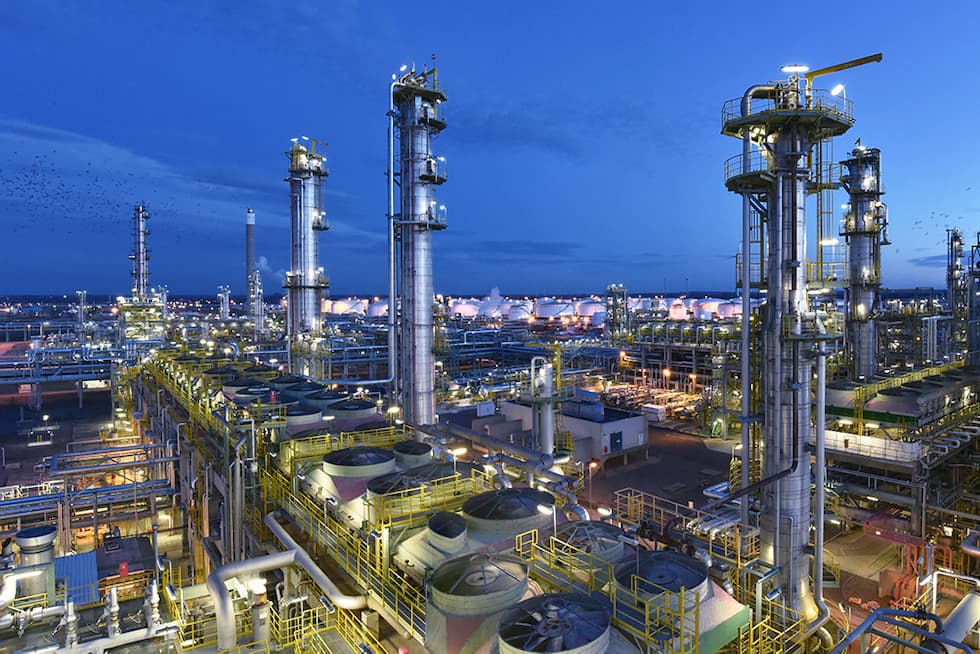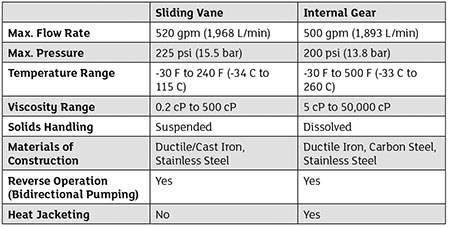
Chemical processing facilities use an array of flowing substances that must be processed, stored and transferred during manufacturing activities. The technology tasked with facilitating this liquid movement is the industrial pump. A number of competing technologies are positioning themselves to grab the attention—and capital investment dollars—of the world’s chemical processors.
The oldest of these battles divided the camp. One camp favored centrifugal pump technology, which uses velocity, momentum and kinetic energy to transfer the liquid when operating at or near its best efficiency point (BEP). The other camp has an affinity for positive displacement (PD) pump technologies, which capture a fixed volume of liquid and transfer it.
With centrifugal pumps, changes to the liquid and system environment directly influence operational capabilities. The operating environment does not affect PD pumps’ efficiency. In recent years, however, the discussion has revolved around another design distinction: Is the best pump—be it PD or centrifugal—for chemical processing applications sealed or sealless?
When choosing a pump, users should consider this question and examine sealless PD sliding vane and internal gear pump technologies.
(Un)sealing the Deal
Sealed pumps use dynamic seals to keep the liquid contained, while sealless pumps do not require dynamic seals to contain the liquid. Sealed pumps can accommodate a constant bleed of trace fluid across the seal faces (even in double seals), whereas sealless pumps offer leak-free operation.
Although sealed pumps remain more common, some analysis has shown that many pump failures originate at the seal. This can be noticeable at chemical processing facilities—wet baseplates and empty baseplates indicate reduced uptime related to a failure in a sealing device.
This does not mean that these failures are solely the seal’s fault. In fact, there are many operational occurrences—pulsation; vibration; shaft deflection; dry run; viscosity, temperature and pressure changes; liquid crystallization and more—that can cause the seal to leak or fail, either of which will put the pump out of service. Sealless pumps should be considered to help reduce downtime and lower maintenance and repair costs.
If a user decides to consider incorporating sealless pumps in a chemical processing operation, the next question becomes, “Which type of sealless pump?” This brings the discussion back to the centrifugal or PD pump conundrum.
There has been recent growth in next-generation sealless designs that feature a magnetic-drive coupling that is used to transmit torque to the pump. In these configurations, a magnetic coupling connects the driving shaft to the driven shaft without use of a dynamic seal to keep the pumped liquids contained.
Admittedly, mag-drive sealless pumps typically have a higher purchase price than basic sealed pumps. However, as the seals and accompanying seal-support systems get more complicated, they get more expensive.
For example, when repairing or replacing a triple-lip seal every 12 to 18 months, that cost will add up, along with the added expense of maintenance or
repair calls. Or, for double mechanical seals that require seal-support systems, the seal-support system adds to the purchase cost, along with associated costs for monitoring equipment.
Financial considerations aside, mag-drive sealless PD pumps offer new functionality. First, sealless PD pumps are self-priming and have good suction lift capabilities. Second, sealless PD pumps allow for bidirectional operation. By rotating the pump forward or backward to achieve line stripping in either direction, users can save on fluid waste and improve safety in the facility. Third, sealless PD pumps are not sensitive to changes in operating environment such as liquid or system conditions. Finally, sealless PD pumps can dry run for extended periods, process suspended solids and accommodate zero net positive suction head available (NPSHa) systems.

Assessing the PD Options
When considering sealless PD options, the most popular for chemical processing applications have been air-operated double diaphragm (AODD) and peristaltic (hose) pumps. The standout feature of both of these technologies is their ability to pull a perfect vacuum, which thereby enables them to self-prime and achieve good suction lift.
Specifically, AODD pumps are a sealless technology choice for utilitarian pumping applications for many reasons: they can be inexpensive, flexible and easy to operate (users need an air hose and suction pipe). There are also some shortcomings: their flow and pressure capacities are narrower than some other PD pump technologies.
They also create pulsation in the liquid path and, because air is expensive, they can be costly to operate, especially when used in continuous-duty applications.
Peristaltic pumps are ideal for handling thick slurries and liquids with large solids and deliver flow rate consistency despite changes in pressure, but their flow rate range is limited and pulsating flow can occur, which makes it difficult to dial in a specific flow rate. From a footprint standpoint, peristaltic pumps are larger than many other technologies, which means they require more operating space. Also, when/if the pump’s hoses fail, a catastrophic leak can occur, and hose degradation during operation can compromise the integrity of more sensitive liquids.
Two of the lesser-known sealless PD pump technologies that feature a mag-drive design are sliding vane and internal gear. These mag-drive pumps are electrically driven, so there is no need for compressed air, and they have a wide and consistent flow rate range and create no pulsation in the liquid. They can also operate well at higher temperatures, are immune to changes in liquid viscosity or pressure and are self-priming, meaning they can prime while being bone dry.
Sliding Vane Technology
Sliding vane technology self-compensates for wear, sustaining new performance throughout the pump’s operational life. Vane pumps allow a wide viscosity and pressure range and are suited for challenging applications like those with suspended solids, varying system pressure, zero NPSHa, liquid/vapor mix and regular dry-run operation. The latest advancement in sliding vane pumps is the sealless magnetic-drive technology.
Reliability: extended and expected dry-run; suspended solids levels of up to 20%; zero-net positive suction head required (NPSHr) performance that is ideal for challenging pump inlet conditions, including pumps with liquids featuring up to 20% vapor or air content, and an uptime provided for without the use of current-monitoring systems.
Functionality: suction lift of more than 25 feet (7.6 meters) without the need to pre-prime the system; provides bidirectional flow; and can line strip to reduce product waste during or after production runs.
Flexibility: a wide operating range that is immune to changing fluid and system conditions; and flow and pressure range achieved with fewer vane pump sizes, optimizing asset flexibility.
Internal Gear Technology
Today’s advanced magnetically coupled internal gear pumps have a simple design that features only seven main components. The heart of the design is a bearing-to-bearing support system that eliminates leaks. The pump’s short spindle also overcomes challenges, namely the impact of overhung loads that can lead to premature wear and failure. Also, internal gear pumps have symmetrical shaft support, which eliminates shaft deflection during operation, resulting in less maintenance and downtime.
Another feature of some magnetically coupled gear pumps is a single-liquid chamber design that improves liquid circulation through the coupling area. This can result in longer magnet life, lower operating temperatures and more efficient cleaning and flushing processes.
The decision to make now involves a choice between PD sealless mag-drive sliding vane and sealless mag-drive internal gear pumps. Image 1 can help the operators of chemical processing facilities decide on the best choice for their specific applications.
Recent advancements in sealless sliding vane and internal gear pump technology provide new functionality, reliability and flexibility for chemical processing facilities. These pump designs are leak-free and help eliminate pervasive pain points.
Now, chemical processors can leverage new options that combine leak-free, sealless performance with the operational advantages that PD sliding vane and gear pumps possess. These new technologies stand ready to be deployed in the most critical chemical processing operations.

